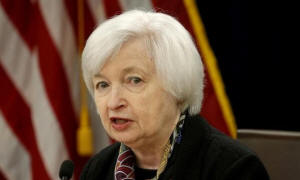|
For Yellen, a September Fed surprise
could close confidence gap
 Send a link to a friend
Send a link to a friend
 [September 19, 2016]
By Howard Schneider [September 19, 2016]
By Howard Schneider
WASHINGTON (Reuters) - Market volatility is
low, U.S. census data shows income gains have reached the middle class,
and workers are clawing back a larger share of national income. For now,
at least, no international risk stands out and inflation may even be
picking up.
If Fed Chair Janet Yellen wants to prove that policymakers are not being
pulled along by investors who for years have second-guessed them, this
week may offer a rare moment of calm to do so.
The Fed is divided enough ahead of its Sept. 20-21 rate meeting that a
nudge from its most influential policymaker could make the difference,
and even some investors have begun to argue it is time for the central
bank to stop worrying so much about what markets expect.
"Let's get on with it already," said Michael Arone, chief investment
strategist at State Street Global Advisors.
"It will cause some challenges to the market but I think that is healthy
in context of a normal business cycle," Arone said. "It will increase
the cost of capital, and flush out some riskier assets in the short
term. But that is probably the right thing to do."
A Reuters poll last week suggested it is a very long shot.

The poll showed the median probability of a rate rise provided by
economists was about one-in-four and only 6 percent of those surveyed
expected the Fed to act, with the majority expecting the Fed to wait
until December.
Fed funds futures trading shows that investors are even more skeptical
than that, and expect the Fed to stay put until February - more than a
year after the central bank raised rates and signaled more would come
this year and next.
Instead the central bank has been stuck at the 0.25 to 0.5 percent range
set last December when it lifted rates for the first time in a decade.
DOUBTS OVER ECONOMY, OR YELLEN?
Many investors, economists, activists, and some policymakers say the
economy is still not ready for higher rates.
The receding rate rise expectations may reflect such concerns about the
U.S. economic recovery. They may also reflect doubts, however, about
Yellen's message that the case for a rate increase is growing stronger.
Such skepticism about the Fed's plans to end policy calibrated to fight
a financial crisis and recession forces officials to perform a difficult
balancing act.
The deeper investors discount the likelihood of Fed action, the greater
the risk any move will trigger an overreaction with unpredictable and
negative economic fallout, making policymakers more hesitant to act.
It is a cycle that may require taking a calculated risk to break,
officials say.
"We are in a minuet with markets and cannot ignore how markets are
pricing," Atlanta Fed president Dennis Lockhart said last week, before
the Fed's blackout period for public comments.
The Fed has been caught in that dance for five years now. While at the
beginning of 2011 trading in euro-dollar futures was still foreseeing a
return to typical interest rates over the next few years, that view has
given way to expectations that rates will remain low for a decade to
come. (Graphic:http://tmsnrt.rs/2cyyvd1)

Those expectations have become deeply anchored and, some argue,
encouraged by the Fed's reluctance to increase rates even as the economy
has approached its employment and inflation targets.
Analysts who follow the Fed complain that its framework has become
confusing: low unemployment and inflation close to the 2 percent target
would not seem consistent with a policy rate more aligned to a
recession.
[to top of second column] |

Federal Reserve Chair
Janet Yellen speaks during a news conference following the two-day
Federal Open Market Committee (FOMC) policy meeting in Washington,
DC, U.S. on March 16, 2016. REUTERS/Kevin Lamarque/File Photo

CACOPHONY
The assorted views of regional bank presidents and board members in
recent weeks muddy the waters further. They have ranged from
warnings of runaway inflation to suggestions the Fed should increase
its inflation target because prices are so weak.
Thrown into the mix as well have been calls for a full-blown policy
overhaul, and a suspicion that the economy may be stuck in a rut
with little anyone can do about it.
Among that chorus of voices, Lael Brainard, a former Obama
administration official and since June 2014 a Fed governor, has
become a central figure in shaping the image of a Fed that errs on
the side of caution when interpreting data and events.
Since the rate debate intensified last year, Brainard has spoken
ahead of five out of the six key policy meetings, laying out her
view that the U.S. recovery could not be taken for granted in a
world of potentially perpetual economic weakness. The quarterly
meetings that end with a news conference are considered the most
likely sessions for Fed action.
She repeated that line last week and called for "prudence,"
effectively stamping out any rate rise speculation..
Brainard's argument seemed prescient last summer when she presented
it the first time. The following 12 months brought market volatility
linked to China's economic weakness and later concerns about the
fallout from Britain's vote to leave the European Union. The turmoil
weighed on the Fed's outlook for the U.S. economy.
Things have since calmed, and through it all the U.S. economy has
continued to generate jobs. Equity markets are up so far this year,
while volatility in the U.S. bond market is near its lowest level
since late 2014.

To be sure, a Bank of America Merrill Lynch measure on expected
swings in the bond market in three months <.MERMOVE3M> did pick up
after the European Central Bank refrained from extending its 1
trillion plus euro bond purchase program. Uncertainty about Bank of
Japan policy, and possible swings in the dollar that could hurt U.S.
manufacturers, remains a risk.
But to some, those risks have become less important than the
uncertainty stemming from the Fed itself.
JP Morgan <JPM.N> chief executive Jamie Dimon said last week it was
the right time for the Fed to move, a call echoed by the country's
credit union sector.
"Folks in the credit union world - the majority want the Federal
Reserve to raise interest rates," said Steve Rick, chief economist
for CUNA Mutual Group, an insurer and financial company whose
products are sold through credit unions.
"A quarter point is not going to kill the economy at all. But you
would have banks more willing and credit unions more willing to lend
if they believe interest rates were giving a clear signal," Rick
said.
(Additional reporting by Richard Leong in New York; Editing by David
Chance and Tomasz Janowski)
[© 2016 Thomson Reuters. All rights
reserved.]
Copyright 2016 Reuters. All rights reserved. This material may not be published,
broadcast, rewritten or redistributed. |